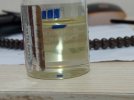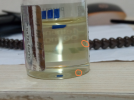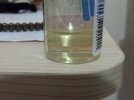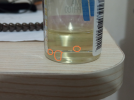Pharmacom Testosterone Undecanoate
Available to purchase at Basicstero (direct link in the "code" box below):
Code:
https://basicstero.ws/testosterones/pharmatest-u-250
Testosterone-Undecanoate Information*:
Testosterone undecanoate (primarily marketed and known from the trade-name “Nebido”), is a very slow-acting ester of testosterone. This is the active drug that is used in Andriol, but in that case it is part of an oral medication, not an injectable. Nebido is being marketed as a replacement for established injectable testosterone products like Delatestryl®, Depo-Testosterone®, and Sustanon®, which are actually much faster acting in comparison. It is designed to offer a much less frequent injection schedule, and, therefore, much greater comfort for the patient. Nebido is a drug developed under a similar focus as testosterone buciclate, which is another very slow-acting injectable ester of testosterone.
History:
Nebido® was developed by international giant Schering AG, Germany (now Bayer). It first surfaced as a prescription drug in Finland and Germany in October and November of 2004, respectively. Within a year it had been approved for sale throughout Europe. Schering/Bayer has since also brought this product to Mexico, Brazil, Argentina, South Africa, Colombia, Korea, Venezuela, and various countries in Eastern Europe (86 countries in total). In July 2005, the U.S. pharmaceuticals firm Indevus purchased the rights to market Nebido under the Aveed trade name. The FDA has since held up U.S. approval of the drug, however, focusing on a small number of adverse reports in Germany. These specifically involve post-injection anaphylactic reactions and pulmonary oil microembolism. Most of these reactions are likely not due to a problem with the drug itself, but incorrect administration of the high-volume injection. Future approval in the U.S. is expected, but unclear.
Nebido® was described by Schering as being the, “first long-acting injection for the treatment of male hypogonadism.” This may be a matter of perspective, as other slow-acting esters do exist. Schering, however, is taking the lead to market in most regions. The applications for Nebido® are extremely narrow, being approved for use in men as a long-term treatment option for low androgen levels only. It is not labeled for use in women, or in males for other uses. Given the growing acceptance of androgen replacement therapy, and the comfort advantage that Nebido® seems to offer male hormone replacement therapy patients (esters like enanthate and cypionate generally require between 13 and 26 injections per year), it may very well become a dominant testosterone product in the years to come, especially with the marketing support of a pharmaceutical giant like Bayer.
Structural Characteristics:
Testosterone undecanoate is a modified form of testosterone, where a carboxylic acid ester (undecanoic acid) has been attached to the 17-beta hydroxyl group. Esterified forms of testosterone are less polar than free testosterone, and are absorbed more slowly from the area of injection. Once in the bloodstream, the ester is removed to yield free (active) testosterone. Esterified forms of testosterone are designed to prolong the window of therapeutic effect following administration, allowing for a less frequent injection schedule compared to injections of free (unesterified) steroid. Nebido® is designed to maintain physiological levels of testosterone for up to 14 weeks after injection.
Side Effects (Estrogenic):
Testosterone is readily aromatized in the body to estradiol (estrogen). The aromatase (estrogen synthetase) enzyme is responsible for this metabolism of testosterone. Elevated estrogen levels can cause side effects such as increased water retention, body fat gain, and gynecomastia. Testosterone is considered a moderately estrogenic steroid. An anti-estrogen such as clomiphene citrate or tamoxifen citrate may be necessary to prevent estrogenic side effects. One may alternately use an aromatase inhibitor like Arimidex® (anastrozole), which more efficiently controls estrogen by preventing its synthesis. Aromatase inhibitors can be quite expensive in comparison to anti-estrogens, however, and may also have negative effects on blood lipids.
Estrogenic side effects will occur in a dose-dependent manner, with higher doses (above normal therapeutic levels) of testosterone more likely to require the concurrent use of an anti-estrogen or aromatase inhibitor. Since water retention and loss of muscle definition are common with higher doses of testosterone, this drug is usually considered a poor choice for dieting or cutting phases of training. Its moderate estrogenicity makes it more ideal for bulking phases, where the added water retention will support raw strength and muscle size, and help foster a stronger anabolic environment.
Side Effects (Androgenic):
Testosterone is the primary male androgen, responsible for maintaining secondary male sexual characteristics. Elevated levels of testosterone are likely to produce androgenic side effects including oily skin, acne, and body/facial hair growth. Men with a genetic predisposition for hair loss (androgenetic alopecia) may notice accelerated male pattern balding. Those concerned about hair loss may find a more comfortable option in nandrolone decanoate, which is a comparably less androgenic steroid. Women are warned of the potential virilizing effects of anabolic/androgenic steroids, especially with a strong androgen such as testosterone. These may include deepening of the voice, menstrual irregularities, changes in skin texture, facial hair growth, and clitoral enlargement. In androgen-responsive target tissues such as the skin, scalp, and prostate, the high relative androgenicity of testosterone is dependent on its reduction to dihydrotestosterone (DHT). The 5-alpha reductase enzyme is responsible for this metabolism of testosterone. The concurrent use of a 5-alpha reductase inhibitor such as finasteride or dutasteride will interfere with site-specific potentiation of testosterone action, lowering the tendency of testosterone drugs to produce androgenic side effects. It is important to remember that anabolic and androgenic effects are both mediated via the cytosolic androgen receptor. Complete separation of testosterone’s anabolic and androgenic properties is not possible, even with total 5-alpha reductase inhibition.
Side Effects (Hepatotoxicity):
Testosterone does not have hepatotoxic effects; liver toxicity is unlikely. One study examined the potential for hepatotoxicity with high doses of testosterone by administering 400 mg of the hormone per day (2,800 mg per week) to a group of male subjects. The steroid was taken orally so that higher peak concentrations would be reached in hepatic tissues compared to intramuscular injections. The hormone was given daily for 20 days, and produced no significant changes in liver enzyme values including serum albumin, bilirubin, alanine-amino-transferase, and alkaline phosphatases.
Side Effects (Cardiovascular):
Anabolic/androgenic steroids can have deleterious effects on serum cholesterol. This includes a tendency to reduce HDL (good) cholesterol values and increase LDL (bad) cholesterol values, which may shift the HDL to LDL balance in a direction that favors greater risk of arteriosclerosis. The relative impact of an anabolic/androgenic steroid on serum lipids is dependent on the dose, route of administration (oral vs. injectable), type of steroid (aromatizable or non-aromatizable), and level of resistance to hepatic metabolism. Anabolic/androgenic steroids may also adversely affect blood pressure and triglycerides, reduce endothelial relaxation, and support left ventricular hypertrophy, all potentially increasing the risk of cardiovascular disease and myocardial infarction.
Testosterone tends to have a much less dramatic impact on cardiovascular risk factors than synthetic steroids. This is due in part to its openness to metabolism by the liver, which allows it to have less effect on the hepatic management of cholesterol. The aromatization of testosterone to estradiol also helps to mitigate the negative effects of androgens on serum lipids. In one study, 280 mg per week of testosterone ester (enanthate) had a slight but not statistically significant effect on HDL cholesterol after 12 weeks, but when taken with an aromatase inhibitor a strong (25%) decrease was seen. Studies using 300 mg of testosterone ester (enanthate) per week for twenty weeks without an aromatase inhibitor demonstrated only a 13% decrease in HDL cholesterol, while at 600 mg the reduction reached 21%. The negative impact of aromatase inhibition should be taken into consideration before such drug is added to testosterone therapy.
Due to the positive influence of estrogen on serum lipids, tamoxifen citrate or clomiphene citrate are preferred to aromatase inhibitors for those concerned with cardiovascular health, as they offer a partial estrogenic effect in the liver. This allows them to potentially improve lipid profiles and offset some of the negative effects of androgens. With doses of 600 mg or less per week, the impact on lipid profile tends to be noticeable but not dramatic, making an anti-estrogen (for cardioprotective purposes) perhaps unnecessary. Doses of 600 mg or less per week have also failed to produce statistically significant changes in LDL/VLDL cholesterol, triglycerides, apolipoprotein B/C-III, C-reactive protein, and insulin sensitivity, all indicating a relatively weak impact on cardiovascular risk factors. When used in moderate doses, injectable testosterone esters are usually considered to be the safest of all anabolic/androgenic steroids.
To help reduce cardiovascular strain it is advised to maintain an active cardiovascular exercise program and minimize the intake of saturated fats, cholesterol, and simple carbohydrates at all times during active AAS administration. Supplementing with fish oils (4 grams per day) and a natural cholesterol/antioxidant formula such as Lipid Stabil or a product with comparable ingredients is also recommended.
Administration (General):
Due to the large injection volume, prescribing guidelines recommend that each injection be given slowly, taking approximately 60 seconds to administer the full dose. Nebido® should always be injected deep in large muscle.
Availability:
Testosterone undecanoate injection continues to increase in prominence as a pharmaceutical product. It is presently approved for sale in 86 countries worldwide. In reviewing some of the more popular products and changes on the global pharmaceutical market, we have made the following observations. Nebido gained approval for Europe-wide sales in 2005. The product has since been distributed throughout Europe, and is widely available in this region. Indevus, a subsidiary of Endo Pharmaceuticals, has continued to push for FDA approval of Aveed in the United States.
*(credit: “ANABOLICS” 10th ed. by William Llewellyn)








